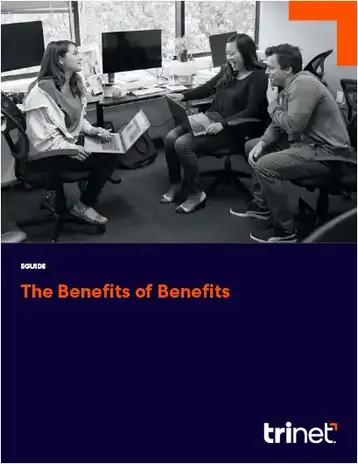
There's a lot on the minds of your employees during open enrollment season. New plans, dates, deadlines, out-of-pocket expenses and other unfamiliar jargon are all up for reexamination. Employee benefits enrollment can be an overwhelming process, but it doesn't have to be. To help your employees through a smooth enrollment process, provide them with explanations of what certain terminology means so they feel fully in the driver's seat. While this won’t apply to all of your employees, offering information about Qualifying Life Events, or QLEs, will be helpful should an employee have experienced a major life change and need to make modifications to their benefits plan outside of the company's open enrollment cycle. Continue reading for a breakdown of the types of QLEs, how to provide proof of said change, and steps needed to take in order to make adjustments during a special enrollment period.
What is open enrollment?
Open enrollment is the 45-day window where employees have the opportunity to sign up for coverage or make modifications to their existing healthcare coverage through their employer. Open enrollment is a crucial time to be prepared for, as employees want to ensure they’re happy with their current plan or that they have an idea for adjustments they'd like to make. It can take part at any time of year, really, but typically, most employers commence their OE during the fall months.
What is a special enrollment period?
A special enrollment period (SEP) is a timeframe in which an employee can modify their current enrollment selections to adjust for any change that may have occurred. Typically, individuals have 60 days to make adjustments to their coverage following the QLE date.
What constitutes a qualifying life event?
If any of your employees have experienced any of the following qualifying life events recently, they're eligible to make changes to their existing benefits plan.
Loss of health coverage
- Losing current health coverage, which include job-based, individual, and student plans
- Losing eligibility for Medicare, Medicaid, or Children's Health Insurance Program (CHIP)
- Turning 26 and losing health coverage from a parent’s plan. If a child leaves the plan due to "aging out" at age 26, the eligible worker can change their coverage accordingly. This is a loss of coverage QLE and the effective date for coverage will be backdated to the date that the coverage officially terminated.
Change in employment status
Undergoing a change in employment status that includes:
- Being hired (keep in mind that if you are a new hire, you may have to satisfy a waiting period)
- Quitting a job or being laid off
- Moving from part-time to full-time
This is a loss of coverage QLE and the effective date for coverage will be backdated to the date that the coverage officially terminated. This applies to both an employee or their dependent.
Change in marital status
- Getting married, which means the employee has the opportunity to add their spouse to their insurance policy within 30 days of the marriage date
- Getting divorced — which would require the employee to either remove a dependent or enroll in their own insurance independently. They can enroll within 30 days of the divorce finalization date.
Changes in household
- Getting married or divorced. If an eligible worker gets married, they can usually add their spouse to their insurance policy within 30 days of the marriage date.
- Having a baby or adopting a child. If an eligible worker has a baby or adopts a child, they can usually add their child to their insurance policy within 30 days of birth.
- Experiencing a loss in their family
Changes in residence
- Relocating to a different ZIP code or county
- Relocating to or from a shelter or other transitional housing
- Moving to or from a school area (if an employee is a student)
- Moving to or from the place that includes both residence and work (if the employee is a seasonal worker)
Other qualifying life events
- An international move to the U.S. If an employee and their dependents move into the U.S., they are qualified to join a plan under a QLE with a passport stamp made in the last 30 days.
- Spousal open enrollment: If an employee has a spouse going through open enrollment, that counts as a qualifying life event. For instance, if an employee’s spouse declines their own insurance to opt into your employees', they are eligible to be added as a dependent.
- Declining marketplace insurance: Declining individual marketplace open enrollment coverage is considered a qualifying life event to enroll in company coverage by many carriers. Please contact your insurance carrier for final confirmation on whether it is considered a QLE.
Is quitting a job a qualifying event for health insurance coverage?
If an employees decide to quit their job, that would trigger a special enrollment period for them that would allow them to enroll in their state's health insurance marketplace.
Is a spouse losing a job a qualifying life event?
Yes — if an employee's spouse experiences a change in their employment, this counts as a qualifying life event. The employee must add their spouse within 31 days of the spouse's loss of coverage.
How long do I have to act on a qualifying life event?
Typically, you will have 60 days from the date of the QLE to make amendments to your current benefits plan. So, if you turned 26 on April 25th, 2022, that is the date that commences your 60 day window to make selections in your new benefits plan. If you got married on May 1, the same applies.
And, just so we're clear, is a new job a qualifying life event?
Yes. When you join a new employer, you will go through an onboarding process that will allow you to make selections based on your current needs. If you plan to be a dependent on your parents' plan or that of a spouse, you can decline coverage at this time. If you qualify for a special enrollment period based on the qualifications above, contact your HR department to understand how you can commence making changes based off of your QLE.
This communication is for informational purposes only; it is not legal, tax or accounting advice; and is not an offer to sell, buy or procure insurance.
This post may contain hyperlinks to websites operated by parties other than TriNet. Such hyperlinks are provided for reference only. TriNet does not control such web sites and is not responsible for their content. Inclusion of such hyperlinks on TriNet.com does not necessarily imply any endorsement of the material on such websites or association with their operators.






